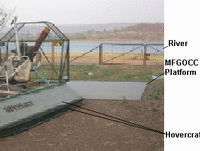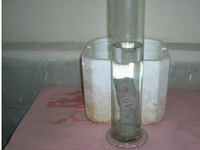For rapid construction of hovercraft landing platforms at sea shore various compositions of oxychloride cement along with sea sand, melamine formaldehyde resin, guar gum and unsaturated polyester resins were prepared for optimization of the suitable composition with optimum compressive stregth and elastic modulus. Based on results obtained further optimization was progressed. Westergaard theory [1] was used to optimize the thickness of platform based on compressive strength achieved of Polymeric cement composite to bear the load of Hovercraft [2]. The Differential Scanning Calorimetric DSC and Thermo-gravimetric TG Analysis were recorded for Guar gum- MF- OCC Composites to determine their thermal stability. Spraying grade MF resin based composites were prepared and vulnerability of their sea sand composites towards encroaching water was studied. After curing, no cracks are developed on the surface. Polymeric concrete composite (PCC) of 1% MF and 1% Low viscosity Guar gum mixed with 25% magnesium oxychloride cement, 12% Fly ash and 60% Sea sand, was found to significantly increase the compressive strength up to 221.02 kg/cm2. This composite is ideally suited to make a rapid landing platform at sea shore and river banks which is not deteriorated by continuous slaps of encroaching water / rains as seen in Trials. Skirt segment is most critical part of hovercraft. The motive for development of polymer based composite concrete was to mitigate the repeated failure of hovercraft skirt segment near the sea shore.Skirt can be damaged very easily since it encounters the obstacles. The skirts material needs to be light, flexible and durable. The deployment areas of operation of the hovercrafts poses always problem for frequent movement of hovercraft for landing due to loose and abrasive nature of sea sand. Life of skirt segment made of nylon and rubber composition reduced to lesser than 150 hours despite its guaranteed life of 500 hours. The skirt segment becomes delaminated and torn within 100 to 150 hours of use. It has been observed that vessel’s initial hovering and switching off period are the critical time. During this period bottom surface of the skirt part of the hovercraft near landing pads undergoes rubbing with abrasive sand, stones and gravels vigorously leading to skirt failure and rapid costly replacements. Therefore cost effective, rapid and easily constructed hovercraft landing platform with the capability of handling smooth operation of the vessel are required at the sea shore. We developed low viscosity guargum polymer solution for rapid preparation of helipad by spray in desert. Guar gum and MF combination with magnesium-oxychloride cement are suitable for compressive moldings and very good load bearing capacity for hovercrafts. Physical properties were determined on specimens prepared under laboratory conditions using applicable ASTM procedures. Technique developed is simple, seawater may be used for making slurry. MF and guar gum resin blends are completely miscible in amorphous state which shows thermal stability of cured blend of MF-Guar gum resin in the temperature of 151-350oC. Locally available aggregates and fillers can be used.No cracks are developed on cured surface. Not damaged by encroaching water or rains.
Like this entry?
-
About the Entrant
- Name:Satish Gupta
- Type of entry:teamTeam members:Dr Sandhya Gupta
Dr Satish Gupta - Software used for this entry:CAD CAM METLAB
- Patent status:patented








